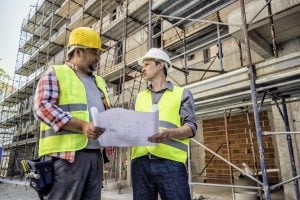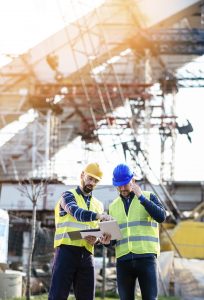You think that a boom lift has little in common with a frame scaffold and you wonder why the US federal Occupational Safety & Health Administration, OSHA, combined the aerial lift standards with the scaffold standards in the same subpart.
You think it should be obvious that a stationary scaffold surrounding a building is nothing like a scissors lift or a mast climber. If that’s what you think, then you might be interested to know that they have a lot more in common than you think. Supported scaffolds, suspended scaffolds and aerial lifts are of the same cloth; there are strength issues, fall hazards, falling object hazards, stability concerns and access matters. It’s true—a boom lift has fall protection hazards just like a suspended scaffold does. Let’s face it, a fall is a fall. Who cares from what platform you fall. There is no doubt that there are unique circumstances for one piece of equipment that would not occur with another. For example, a boom lift can provide the operator with a catapult toss that one would not experience on a supported scaffold. Consequently, a boom lift operator needs fall restraint in addition to a guardrail system. Interestingly, besides the logical solutions to fall hazards, temporary elevated platforms have taken on a new dimension, mainly due to a misunderstanding of the hazards. Scissors lifts now have fall protection anchors, similar to boom lifts so that occupants can utilize fall arrest equipment in addition to a guardrail system that keeps them from walking off the platform. It appears to be an unnecessary inconvenience but some say that both suspenders and a belt are better. Simply stated, fall protection for temporary elevated platforms is determined by the type of equipment and the potential hazard: common hazard, unique solution.
It is unquestioned that all scaffolds must support the intended load. The common question asks how strong is strong enough. For supported and suspended scaffolds, each scaffold must be able to support four times the load applied while the suspension ropes for suspended scaffolds must be six times stronger than the intended load. That’s right, six times! Mast climbers have an interesting characteristic not often seen with other types of scaffolds. Unbalanced loads will tip the whole platform over, definitely not a good situation. Therefore it’s really important to follow the manufacturer’s recommendations regarding the placement of loads. This holds true for construction hoists where some people think that if the cage isn’t full, more load can be added. This is not a good idea.
Supported scaffolds can support thousands of pounds while boom lifts may be limited to a couple of workers. Suspended scaffolds can be designed for only a couple of workers and they can be designed for multiple personnel. The common thread is that all scaffolds, aerial lifts and construction hoists are designed to support loads; each exhibits a unique characteristic for doing so.
A proper foundation is required for any structure including construction hoists, aerial lifts and other scaffolds. Here a foundation is not the basement of the building but rather the support for the equipment. This foundation can be the ground, a floor, a roof, a beam, even water. That’s right; I saw a scaffold in a swimming pool supported by pontoons. Don’t ask!
A boom lift or scissors lift will apply its load through four wheels. As the machine drives around on the building floor it will exert loads in a way that may not have been anticipated by the design engineer. This may result in a damaged floor or worse. On the other hand, a mast climber typically applies its load to a very small base. Does the foundation have the capacity to support this type of concentrated load or does the load need to be spread out over a larger area? If the machine is setting on a floor, can the floor handle that type of load or will reshoring be required to transfer the load to a stronger foundation for the machine?
The common thread is that all scaffolds, aerial lifts and construction hoists require an adequate foundation. The unique attribute is how the load is applied to that foundation.
Access is necessary for any floor or platform, including temporary elevated platforms. However, what may work for a stationary scaffold won’t necessarily work for an aerial lift. Ladders are commonly used to access frame scaffolds although I cannot imagine using a portable ladder to access a boom lift. But I can imagine using a boom lift to access a frame scaffold. Its normally not a good idea to use a portable ladder to access a mast climber since the mast climber can exceed the height of the ladder, rendering it useless of worse; same thing with a suspended scaffold and an adjustable scaffold. Ramps work well with construction hoists and may also work well with a supported scaffold. Access is a common requirement, the solution is unique.
So, it does make sense to include supported scaffolds, those scaffolds whose platforms are supported by rigid means, suspended scaffolds, those scaffolds whose platforms are supported by non-rigid means, and aerial lifts in one set of standards. The hazards are common but the solutions are unique. Make sure you know both.













